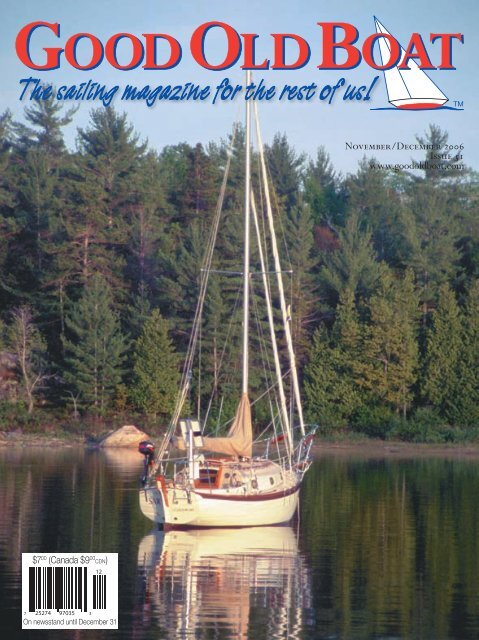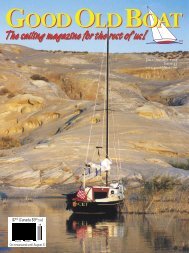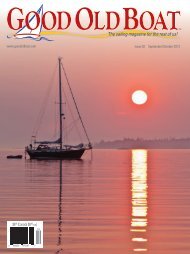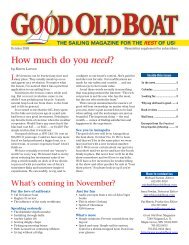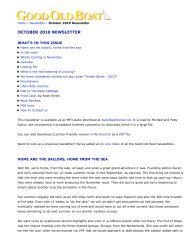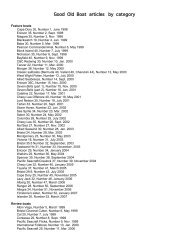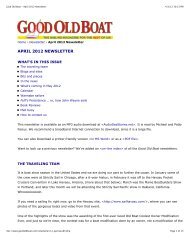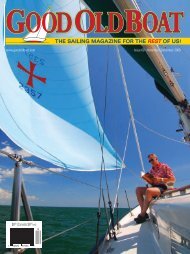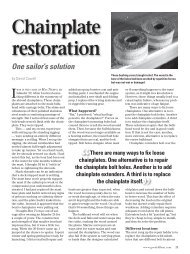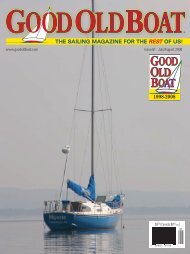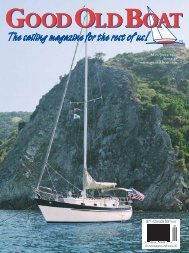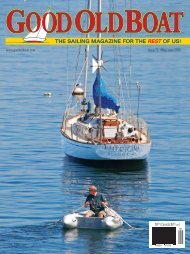The sailing magazine for the rest of us! - Good Old Boat Magazine
The sailing magazine for the rest of us! - Good Old Boat Magazine
The sailing magazine for the rest of us! - Good Old Boat Magazine
You also want an ePaper? Increase the reach of your titles
YUMPU automatically turns print PDFs into web optimized ePapers that Google loves.
<strong>The</strong> <strong>sailing</strong> <strong>magazine</strong> <strong>for</strong> <strong>the</strong> <strong>rest</strong> <strong>of</strong> <strong>us</strong>!<br />
November/December 2006<br />
Issue 51<br />
www.goodoldboat.com<br />
$7 00 (Canada $9 00 CDN)<br />
12<br />
7 25274 97035 3<br />
On newsstand until December 31
Pr<strong>of</strong>ile<br />
Sampatecho<br />
A floating test-bed<br />
<strong>for</strong> cruising equipment<br />
by Barry Hammerberg<br />
WE FIRST SAW SAMPATECHO, A 15-<br />
year-old Beneteau 390, lying at<br />
anchor at Solomon Landing on<br />
Chesapeake Bay. Her c<strong>us</strong>tom aft arch<br />
— supporting radar, a solar panel, and a<br />
wind generator — identified her as a serio<strong>us</strong><br />
cruising boat. <strong>The</strong> Canadian flag<br />
at her transom rein<strong>for</strong>ced <strong>the</strong> image.<br />
It was not until we arrived in Cape<br />
May a week later that we met Sampatecho’s<br />
owners, Bradd and Maeve Wilson.<br />
We talked and exchanged stories<br />
that ultimately led to friendship. We<br />
cruised toge<strong>the</strong>r <strong>for</strong> what began as a<br />
couple <strong>of</strong> days and turned into three<br />
months <strong>of</strong> exploration and shared<br />
good times. We parted at Mackinac<br />
Island — <strong>the</strong>y were to journey back<br />
to Caribbean waters and we were to<br />
return to Wisconsin.<br />
<strong>The</strong>y left with <strong>us</strong> <strong>the</strong> story <strong>of</strong> a<br />
couple with a passion <strong>for</strong> <strong>sailing</strong>, <strong>the</strong>ir<br />
experiences in outfitting two boats<br />
<strong>for</strong> a cruising lifestyle, and how <strong>the</strong>y<br />
<strong>for</strong>med <strong>the</strong>ir company, Cruising Solutions,<br />
to help o<strong>the</strong>rs find economical<br />
answers <strong>for</strong> <strong>the</strong>ir equipment needs.<br />
As a youth, Bradd began <strong>sailing</strong> in<br />
small boats. As an adult, he had owned<br />
a 15-foot gaff-rigged catboat, a Venture<br />
22, and a Viking 28. He’d raced <strong>the</strong> last<br />
two extensively. He had chartered in<br />
<strong>the</strong> British Virgin Islands and Florida.<br />
Along <strong>the</strong> way, he had qualified <strong>for</strong> his<br />
captain’s license and made delivery<br />
trips. In order to be near boats, he’d<br />
left <strong>the</strong> automotive ind<strong>us</strong>try to manage<br />
Sugarloaf Marina in Port Colborne,<br />
Ontario. Sailing was in his blood.<br />
Charter experience<br />
Maeve was introduced to <strong>sailing</strong> later<br />
in life. She had gained Laser and charter<br />
experience in <strong>the</strong> Tho<strong>us</strong>and Island<br />
area <strong>of</strong> <strong>the</strong> St. Lawrence River be<strong>for</strong>e<br />
she met Bradd. <strong>The</strong>ir mutual affinity<br />
<strong>for</strong> water and inte<strong>rest</strong> in a lifestyle<br />
<strong>of</strong> exploration, meeting people, and<br />
coexisting with nature made cruising<br />
on a sailboat a natural choice. <strong>The</strong>y’d<br />
had a taste <strong>of</strong> it while on charter vacations;<br />
<strong>the</strong>y wanted more.<br />
With an aft arch, which supports radar,<br />
wind generator, and solar panels, Sampatecho,<br />
above, has <strong>the</strong> look <strong>of</strong> a cruising<br />
boat. Owners <strong>of</strong> this 15-year-old<br />
Beneteau Oceanis 390 are Bradd and<br />
Maeve Wilson, inset, <strong>the</strong> liveaboard<br />
owners <strong>of</strong> Cruising Solutions.<br />
<strong>The</strong> Viking 28 wasn’t adequate <strong>for</strong><br />
extended family cruising. <strong>The</strong>y needed<br />
a boat with room <strong>for</strong> three teenagers<br />
and <strong>the</strong>mselves. <strong>The</strong> next boat had<br />
to have easy access <strong>for</strong> swimmers, as<br />
<strong>the</strong>ir kids loved <strong>the</strong> water. Bradd wanted<br />
speed to reduce <strong>the</strong> time necessary<br />
to cover long distances and to open up<br />
more wea<strong>the</strong>r options. <strong>The</strong> boat also<br />
had to be easily handled by a couple.<br />
www.goodoldboat.com 29
Pr<strong>of</strong>ile<br />
<strong>The</strong> stat<strong>us</strong> <strong>of</strong> Sampatecho’s wind generator<br />
can be seen at a glance with a wallmounted<br />
display, top photo. <strong>The</strong> egg-shaped<br />
unit provides <strong>the</strong> generating stat<strong>us</strong> while<br />
<strong>the</strong> ammeter tells how much current is<br />
being put out. <strong>The</strong> view <strong>of</strong> <strong>the</strong> Perkins,<br />
above, shows Bradd’s mount <strong>for</strong> his second<br />
alternator on top <strong>of</strong> <strong>the</strong> engine. <strong>The</strong> stock<br />
alternator is at <strong>the</strong> bottom right. <strong>The</strong> idler<br />
in <strong>the</strong> middle <strong>of</strong> <strong>the</strong> belt provides tension<br />
and permits <strong>the</strong> belt to be slackened and<br />
removed when Bradd doesn’t want <strong>the</strong> second<br />
alternator running. A look at Sampatecho’s<br />
cockpit accommodations, below.<br />
Bradd researched boats, finally deciding<br />
that a C&C Landfall 38 would<br />
meet <strong>the</strong>ir needs. It was designed as a<br />
cruiser/racer, had good tank capacity,<br />
and was seakindly. <strong>The</strong>y went to<br />
Ft. Lauderdale in 1995 to search <strong>for</strong><br />
a Landfall. After being ignored <strong>for</strong> 20<br />
minutes by a broker who had a few<br />
Landfalls to show, <strong>the</strong>y walked over<br />
to <strong>the</strong> nearby Moorings docks . . . j<strong>us</strong>t<br />
to look around. Bradd had already<br />
discounted <strong>the</strong> Moorings <strong>of</strong>ferings<br />
as too new, too expensive, too much<br />
boat <strong>for</strong> <strong>the</strong>ir needs, and too worn<br />
from chartering. <strong>The</strong>y were j<strong>us</strong>t looking<br />
<strong>for</strong> ideas.<br />
Needs analysis<br />
But Bob Ross <strong>of</strong> <strong>the</strong> Moorings was<br />
everything <strong>the</strong> prevo<strong>us</strong> broker was<br />
not. He asked about <strong>the</strong>ir plans and<br />
past experiences. When he had a good<br />
picture <strong>of</strong> what <strong>the</strong>y were looking <strong>for</strong>,<br />
he suggested a boat that had j<strong>us</strong>t arrived<br />
and had not yet been cleaned. It<br />
was a 1990 Beneteau Oceanis 390 j<strong>us</strong>t<br />
in from four years <strong>of</strong> charter service.<br />
It was one <strong>of</strong> six a French owner had<br />
bought. Planning to <strong>us</strong>e it himself,<br />
he’d squirreled this one away in Guadaloupe<br />
where it didn’t get a lot <strong>of</strong> <strong>us</strong>e.<br />
He didn’t have time, however, and it<br />
wasn’t being chartered enough, so he<br />
had instructed <strong>the</strong> Moorings to sell it.<br />
<strong>The</strong> original owner had replaced <strong>the</strong><br />
27-hp Volvo with a 50-hp Perkins. <strong>The</strong><br />
boat also had new lines and a bon<strong>us</strong>:<br />
spinnaker gear. Un<strong>for</strong>tunately, it didn’t<br />
have shorepower, holding tanks, or<br />
instruments beyond basic speed and<br />
depth. <strong>The</strong> boat was clean, although<br />
it was anyone’s guess what it had suffered<br />
at <strong>the</strong> hands <strong>of</strong> charterers.<br />
Maeve liked <strong>the</strong> swim plat<strong>for</strong>m,<br />
three-cabin layout, two heads, and big<br />
saloon. Bradd liked its construction<br />
and speed. <strong>The</strong>y hadn’t intended to<br />
commit to a boat during <strong>the</strong>ir trip, but<br />
<strong>the</strong>y made an <strong>of</strong>fer that was accepted.<br />
<strong>The</strong> franc-to-Canadian-dollar exchange<br />
rate saved <strong>the</strong>m $4,000; it was<br />
meant to be.<br />
Three changes<br />
Not long afterward, Bradd returned<br />
<strong>for</strong> a survey and sea trial. <strong>The</strong> 390 per<strong>for</strong>med<br />
well in light air and was very<br />
responsive to <strong>the</strong> helm and trim. His<br />
surveyor required three changes. <strong>The</strong><br />
most major <strong>of</strong> <strong>the</strong>se was some re-tabbing<br />
on <strong>the</strong> floor grid.<br />
Bradd completed <strong>the</strong> purchase and<br />
brought back a little mermaid statue <strong>for</strong><br />
Maeve. He taped <strong>the</strong> key to <strong>the</strong>ir new<br />
boat on <strong>the</strong> bottom <strong>of</strong> <strong>the</strong> mermaid, as a<br />
signal that <strong>the</strong> boat was <strong>the</strong>irs.<br />
<strong>The</strong> name Sampatecho is a combination<br />
<strong>of</strong> <strong>the</strong> children’s names, Sam,<br />
Pat, and Echo. <strong>The</strong> Spanish word<br />
simpatico means congenial; something<br />
that is in sympathy with its<br />
surroundings; at peace with nature.<br />
Since it was a similar word, <strong>the</strong>y felt<br />
that Sampatecho reflected <strong>the</strong>ir life<br />
philosophies.<br />
Bradd believed <strong>the</strong>y had acquired a<br />
basic hull, interior, and rig at $30,000<br />
below market value. <strong>The</strong>y spent almost<br />
$4,000 to ship her to Buffalo,<br />
New York, where <strong>the</strong>y launched and<br />
sailed her home to Port Colborne,<br />
Ontario. It would have cost ano<strong>the</strong>r<br />
$5,000 if <strong>the</strong>y’d shipped her to Canada<br />
over <strong>the</strong> Peace Bridge: <strong>the</strong> cost <strong>of</strong><br />
permits, escorts, and closing one lane<br />
<strong>of</strong> traffic.<br />
It was time to find out if <strong>the</strong>y could<br />
live aboard. <strong>The</strong>y rented out <strong>the</strong>ir<br />
home and moved aboard with <strong>the</strong>ir<br />
children <strong>for</strong> <strong>the</strong> summer. <strong>The</strong> 390<br />
needed a few modifications. <strong>The</strong>y added<br />
a holding tank (one head still has<br />
only bluewater discharge), added a<br />
macerator (<strong>for</strong> <strong>of</strong>fshore <strong>us</strong>e), installed<br />
shorepower, and converted <strong>the</strong> engine-driven<br />
refrigerator holding plate<br />
to a 12-volt holding plate. <strong>The</strong>y added<br />
cupboards and shelves. Bradd moved<br />
<strong>the</strong> water heater from under a settee<br />
to an aft locker and <strong>us</strong>ed <strong>the</strong> space <strong>for</strong><br />
storage. New instruments and an autopilot<br />
finished <strong>the</strong> initial conversion to<br />
a family cruiser.<br />
<strong>The</strong> adventure begins<br />
In 1997, <strong>the</strong>y qualified <strong>for</strong> homestudy<br />
tutoring, took <strong>the</strong> children out<br />
<strong>of</strong> school, and went south <strong>for</strong> four<br />
months. <strong>The</strong> children were aged 10,<br />
14, and 16. One lesson that Bradd and<br />
Maeve learned all too soon is that<br />
extended cruising doesn’t work <strong>for</strong><br />
teenagers who prefer to be home with<br />
<strong>the</strong>ir friends. So, <strong>the</strong>ir cruising dream<br />
was put on hold. <strong>The</strong>y brought <strong>the</strong><br />
Beneteau home to Port Colborne <strong>for</strong><br />
family summer cruises.<br />
In order to live aboard <strong>for</strong> part <strong>of</strong><br />
each winter season, at least, Bradd<br />
and Maeve purchased a second boat in<br />
1998. This one, named Enchanté, was<br />
a 1978 Endeavor 32. She was based in<br />
30 GOOD OLD BOAT November/December 2006
Florida, and from <strong>the</strong>re <strong>the</strong>y spent a<br />
month cruising each spring and fall.<br />
Enchanté became something <strong>of</strong> a test<br />
boat <strong>for</strong> <strong>the</strong>ir cruising lifestyle. Bradd<br />
researched systems, installed <strong>the</strong>m,<br />
and tested <strong>the</strong>m in <strong>the</strong> real world <strong>of</strong><br />
Caribbean cruising. He soon realized<br />
that <strong>the</strong>y were slaves to refrigeration.<br />
<strong>The</strong>y also needed electricity <strong>for</strong><br />
instruments and lighting. Power consumption<br />
dictated that <strong>the</strong>y be able to<br />
generate and store electricity and find<br />
ways to reduce demand.<br />
Bradd installed a bank <strong>of</strong> AGM batteries,<br />
shorepower, a charger, and a<br />
wind generator. He reduced demand<br />
with more. Now that <strong>the</strong> kids were<br />
older, <strong>the</strong>y wanted to be aboard <strong>for</strong> a<br />
couple <strong>of</strong> weeks at a time. Eventually,<br />
Bradd and Maeve decided to keep <strong>the</strong><br />
Beneteau and sell <strong>the</strong> Endeavor.<br />
It was time to prepare <strong>the</strong> Beneteau<br />
<strong>for</strong> extended living aboard, based on<br />
lessons learned on <strong>the</strong> Endeavor. <strong>The</strong><br />
list <strong>of</strong> additions to <strong>the</strong> Beneteau grew<br />
as <strong>the</strong>y incorporated <strong>the</strong>ir wish list.<br />
First, Bradd addressed <strong>the</strong>ir basic<br />
electrical systems. He added a 110-volt<br />
AC distribution system, 12-volt DC<br />
outlets <strong>for</strong> accessories like <strong>the</strong> handheld<br />
radio, cabin fans, and compact<br />
fluorescent lights in <strong>the</strong> cabins. Next,<br />
Bradd researched systems,<br />
installed <strong>the</strong>m, and tested <strong>the</strong>m in<br />
<strong>the</strong> real world <strong>of</strong> Caribbean cruising.<br />
by changing interior lights to compact<br />
fluorescent lighting. <strong>The</strong> Endeavor<br />
had <strong>the</strong> icebox to die <strong>for</strong>: 12 cubic<br />
feet. <strong>The</strong>y mounted an efficient 12-volt<br />
cold plate under <strong>the</strong> cover to reduce<br />
<strong>the</strong> demand <strong>for</strong> ice. A propane oven<br />
upgraded <strong>the</strong> galley.<br />
He next addressed peace-<strong>of</strong>-mind<br />
issues. He upgraded instruments<br />
and ground tackle. He installed dual<br />
anchor rollers to support a primary<br />
30-pound CQR anchor with 66 feet <strong>of</strong><br />
chain and 200 feet <strong>of</strong> rode and a 35-<br />
pound Dan<strong>for</strong>th anchor with 20 feet <strong>of</strong><br />
chain and 150 feet <strong>of</strong> nylon.<br />
Comparing notes<br />
About this time John Van Blois and<br />
Bradd <strong>for</strong>med Cruising Solutions, although<br />
John has since left <strong>the</strong> company<br />
to Bradd and Maeve and serves as an<br />
advisor. <strong>The</strong>ir big idea started when <strong>the</strong><br />
two men sat toge<strong>the</strong>r at John’s kitchen<br />
table comparing notes on equipping a<br />
cruising boat. Both had done a lot <strong>of</strong><br />
research and sought a way to share<br />
this knowledge with o<strong>the</strong>rs. <strong>The</strong>y<br />
envisioned starting a company selling<br />
cruising gear <strong>the</strong>y had tested and could<br />
recommend without hesitation.<br />
Bradd and Maeve continued <strong>sailing</strong><br />
<strong>the</strong> Bahamas, Florida Keys, and<br />
Cuba, learning during <strong>the</strong>ir monthlong<br />
cruises that <strong>the</strong> Endeavor was<br />
adequate <strong>for</strong> two people but crowded<br />
he added a radar system with an arch<br />
that incorporates seats, a motor hoist,<br />
motor mount, rod holders, and anchor<br />
light. He also added a swim ladder,<br />
<strong>of</strong>fshore life raft, and watermaker.<br />
Adding equipment<br />
Crew needs were addressed by adding<br />
a microwave oven, larger winches<br />
(Lewmar 58s), an electric windlass, Bimini,<br />
dodger, and a propane barbecue.<br />
Bradd realized <strong>the</strong>y’d need to be<br />
energy self-sufficient. His system <strong>for</strong><br />
energy production and management<br />
is well researched. He <strong>us</strong>ed Nigel<br />
Calder’s <strong>for</strong>mulas to figure demand,<br />
planning to run <strong>the</strong> engine about two<br />
hours every fourth day to replenish<br />
<strong>the</strong> batteries. He knew he’d need a<br />
respectable ho<strong>us</strong>e bank and passive<br />
generation to extend amp-hours by<br />
keeping ahead <strong>of</strong> <strong>the</strong> demands <strong>of</strong> refrigeration.<br />
With this in mind, <strong>the</strong> following<br />
items were added to <strong>the</strong> boat: a<br />
660-amp-hour ho<strong>us</strong>e battery bank pl<strong>us</strong><br />
a starting battery, a 100-amp alternator<br />
to supplement <strong>the</strong> original 55-amp<br />
unit, one 55-watt solar panel, and a<br />
Rutland 913 wind generator.<br />
Bradd figures <strong>the</strong>ir solar panel puts<br />
out daily about 3 amps <strong>for</strong> four hours<br />
and 1.5 amps <strong>for</strong> ano<strong>the</strong>r four hours.<br />
He chose <strong>the</strong> Rutland 913 beca<strong>us</strong>e<br />
he wanted a unit capable <strong>of</strong> generating<br />
in less than 10 knots <strong>of</strong> wind in<br />
Over <strong>the</strong> years, Sampatecho has<br />
become <strong>the</strong> com<strong>for</strong>table cruising home<br />
and <strong>the</strong> place <strong>of</strong> b<strong>us</strong>iness <strong>for</strong> Bradd<br />
and Maeve, who are breaking ground<br />
as sailors who combine <strong>the</strong>ir work and<br />
cruising lifestyles. <strong>The</strong>y sometimes<br />
teeter at <strong>the</strong> leading edge <strong>of</strong> communication<br />
technology with <strong>the</strong> associated<br />
fr<strong>us</strong>trations, but Bradd and Maeve are<br />
showing o<strong>the</strong>rs that <strong>the</strong> b<strong>us</strong>inessaboard<br />
dream works <strong>for</strong> <strong>the</strong>m.<br />
www.goodoldboat.com 31
Pr<strong>of</strong>ile<br />
only two hours every fourth day to<br />
maintain <strong>the</strong>ir batteries.<br />
<strong>the</strong> calmer areas <strong>the</strong>y seek <strong>for</strong> shelter<br />
and anchoring. Bradd calculates <strong>the</strong><br />
Rutland quietly averages a continuo<strong>us</strong><br />
2 amps.<br />
<strong>The</strong> 100-amp alternator is engaged<br />
only when he needs to replenish <strong>the</strong><br />
ho<strong>us</strong>e bank. He designed a system <strong>for</strong><br />
easily mounting or removing <strong>the</strong> drive<br />
<br />
belt on <strong>the</strong> 100-amp alternator (see<br />
photo on Page 30). <strong>The</strong> 55-amp unit<br />
is always engaged. A nice feature <strong>of</strong><br />
this arrangement is that both alternators<br />
are self-regulating and serve as<br />
backups.<br />
His system proved itself in <strong>the</strong> Bahamas.<br />
As hoped, <strong>the</strong>y ran <strong>the</strong>ir diesel<br />
<br />
<br />
<br />
<br />
<br />
<br />
<br />
<br />
<br />
<br />
<br />
<br />
<br />
<br />
<br />
<br />
<br />
<br />
<br />
<br />
<br />
<br />
<br />
<br />
<br />
<br />
<br />
<br />
<br />
<br />
<br />
<br />
<br />
<br />
Upgraded anchors<br />
<strong>The</strong> original ground tackle was upgraded<br />
to include a 40-pound CQR<br />
with 150 feet <strong>of</strong> 3 ⁄8-inch chain and as<br />
<strong>the</strong>ir secondary, a 35-pound West<br />
Per<strong>for</strong>mance (Dan<strong>for</strong>th style) with<br />
66 feet <strong>of</strong> 3 ⁄8-inch chain and 150 feet<br />
<strong>of</strong> ¾-inch nylon. Bradd acknowledges<br />
that he sleeps better with all-chain<br />
rode. This was rein<strong>for</strong>ced one night on<br />
<strong>the</strong> Bahamas Bank when <strong>the</strong>y chafed<br />
through a 1-inch nylon snubber line in<br />
eight hours.<br />
Finally, Sampatecho was ready.<br />
Bradd and Maeve sold <strong>the</strong>ir ho<strong>us</strong>e, disposed<br />
<strong>of</strong> <strong>the</strong> cars, stored heirlooms,<br />
and headed down <strong>the</strong> East Coast.<br />
Meanwhile, Cruising Solutions had<br />
continued to grow, adding c<strong>us</strong>tomers<br />
and products. Bradd and Maeve’s<br />
b<strong>us</strong>iness had morphed into something<br />
more than simply serving as <strong>the</strong> representative<br />
<strong>for</strong> chosen products, as existing<br />
suppliers closed and Bradd and<br />
Maeve began developing <strong>the</strong>ir own<br />
new products. <strong>The</strong>y now had contract<br />
manufacturers, inventory, shipping,<br />
and product development to contend<br />
with.<br />
Does it work?<br />
So how do <strong>the</strong>y run a b<strong>us</strong>iness while<br />
cruising? Bradd and Maeve exhibit at<br />
boat shows, test gear, and run <strong>the</strong>ir<br />
b<strong>us</strong>iness as a virtual company. <strong>The</strong>y<br />
handle questions, issues, product<br />
development, and acquisition. Until recently,<br />
<strong>the</strong>ir son, Pat, processed orders<br />
each day and cleared <strong>the</strong> spam from<br />
<strong>the</strong>ir email account back at home. But<br />
Pat, age 23, is crewing on a 165-foot<br />
yacht now and his younger bro<strong>the</strong>r,<br />
Craw<strong>for</strong>d (Sam), has <strong>the</strong> job. Shipping<br />
is handled by a contractor in Florida.<br />
<strong>The</strong>y liken <strong>the</strong>ir b<strong>us</strong>iness to a wind<br />
generator: it doesn’t provide enough<br />
income to fully support <strong>the</strong>ir cruising,<br />
but it does help extend <strong>the</strong> life <strong>of</strong> <strong>the</strong><br />
battery bank. It also puts demands on<br />
<strong>the</strong>ir liveaboard lifestyle.<br />
Maeve notes, “Five years ago we<br />
couldn’t be <strong>sailing</strong> and run <strong>the</strong> b<strong>us</strong>iness.”<br />
She points out that efficient<br />
communication wasn’t possible. Cellular<br />
phones and <strong>the</strong> Internet make<br />
it possible today, possible but not<br />
simple.<br />
32 GOOD OLD BOAT November/December 2006
Bradd adds, “<strong>The</strong><br />
Internet has changed<br />
people’s expectations.<br />
Once, you<br />
clipped a bingo card<br />
from a <strong>magazine</strong>,<br />
waited a few weeks <strong>for</strong> literature,<br />
<strong>the</strong>n called or sent in an order. Today,<br />
you research <strong>the</strong> info on <strong>the</strong> Internet,<br />
enter your order, and expect shipment<br />
<strong>the</strong> same day. We have to be accessible,<br />
always, 24/7.”<br />
High-tech headaches<br />
<strong>The</strong>y have learned that cell phones<br />
are a blessing and a curse. <strong>The</strong>y<br />
promise mobile communication but<br />
fall short on connection reliability.<br />
<strong>The</strong> places where sailors are found<br />
— rivers, lakes, and oceans — don’t<br />
have enough potential <strong>us</strong>ers to support<br />
nearby service providers and cell<br />
towers. Emerging technologies such<br />
as tower signal-strength modulation,<br />
directional signals, and traffic-flow<br />
control diminish a boater’s ability to<br />
connect.<br />
All <strong>the</strong> elements <strong>of</strong> a small b<strong>us</strong>iness<br />
are in place; it’s j<strong>us</strong>t not all in one place.<br />
Cruising Solutions has become a model<br />
<strong>for</strong> a small virtual b<strong>us</strong>iness.<br />
Simple things, such as changing<br />
your coverage plan, can result<br />
in weeks without service. Costs can<br />
escalate out <strong>of</strong> control when roaming<br />
charges kick in, especially <strong>of</strong>fshore,<br />
or when you’re traveling along a border<br />
where direct and roaming towers<br />
compete <strong>for</strong> your signal. In o<strong>the</strong>r<br />
areas, days would pass without a reliable<br />
connection.<br />
After many months <strong>of</strong> communication<br />
fr<strong>us</strong>trations, Bradd and Maeve<br />
purchased a SkyMate satellite communicator,<br />
which provides af<strong>for</strong>dable<br />
and reliable global wea<strong>the</strong>r <strong>for</strong>ecasts,<br />
secure email, position reporting to<br />
friends and family, voice messaging,<br />
and fax capabilities. <strong>The</strong>y also<br />
switched <strong>the</strong>ir cell phone provider<br />
from Sprint to Cingular, which <strong>of</strong>fers<br />
superior coverage in Canada and <strong>the</strong><br />
Bahamas. A Black-<br />
Berry (a small wireless<br />
email and web accessing<br />
device) is on <strong>the</strong><br />
wish list, <strong>the</strong>y say, but<br />
<strong>the</strong>y’re on a cruising<br />
budget like everybody else. Maybe<br />
that technology will be tested later.<br />
As <strong>the</strong>y face communication<br />
complications and changes, <strong>the</strong>y are<br />
backed up by <strong>the</strong>ir “virtual infrastructure.”<br />
Craw<strong>for</strong>d, age 20, does much <strong>of</strong><br />
<strong>the</strong> communications and <strong>of</strong>fice work.<br />
Payments are processed via telephone<br />
from orders placed on <strong>the</strong>ir website<br />
or called in to <strong>the</strong>ir toll-free number.<br />
Maeve handles <strong>the</strong> accounting with<br />
<strong>the</strong> help <strong>of</strong> <strong>the</strong>ir accountant. Artwork<br />
<strong>for</strong> advertising and promotion is developed<br />
by <strong>the</strong>ir daughter, Echo, age<br />
26. Craw<strong>for</strong>d also assists with product<br />
evaluation and data entry.<br />
All <strong>the</strong> elements <strong>of</strong> a small b<strong>us</strong>iness<br />
are in place; it’s j<strong>us</strong>t not all in<br />
one place. Cruising Solutions has<br />
become a model <strong>for</strong> a small virtual<br />
b<strong>us</strong>iness.<br />
<br />
<br />
<br />
<br />
<br />
<br />
<br />
<br />
<br />
<br />
<br />
<br />
<br />
<br />
<br />
<br />
<br />
<br />
<br />
<br />
<br />
<br />
<br />
BETA MARINE US Ltd.<br />
P O B o x 5 , A r a p a h o e , N C 2 8 5 1 0<br />
8 0 0 - 6 8 2 - 8 0 0 3 • 2 5 2 - 2 4 9 - 2 4 7 3 • f a x 2 5 2 - 2 4 9 - 0 0 4 9<br />
i n f o @ b e t a m a r i n e n c . c o m<br />
www.betamarine.net<br />
www.goodoldboat.com 33


